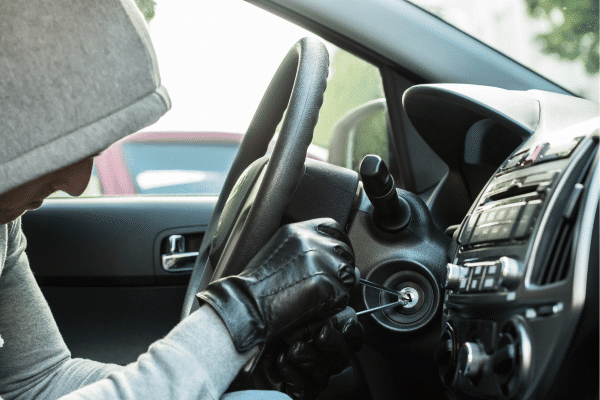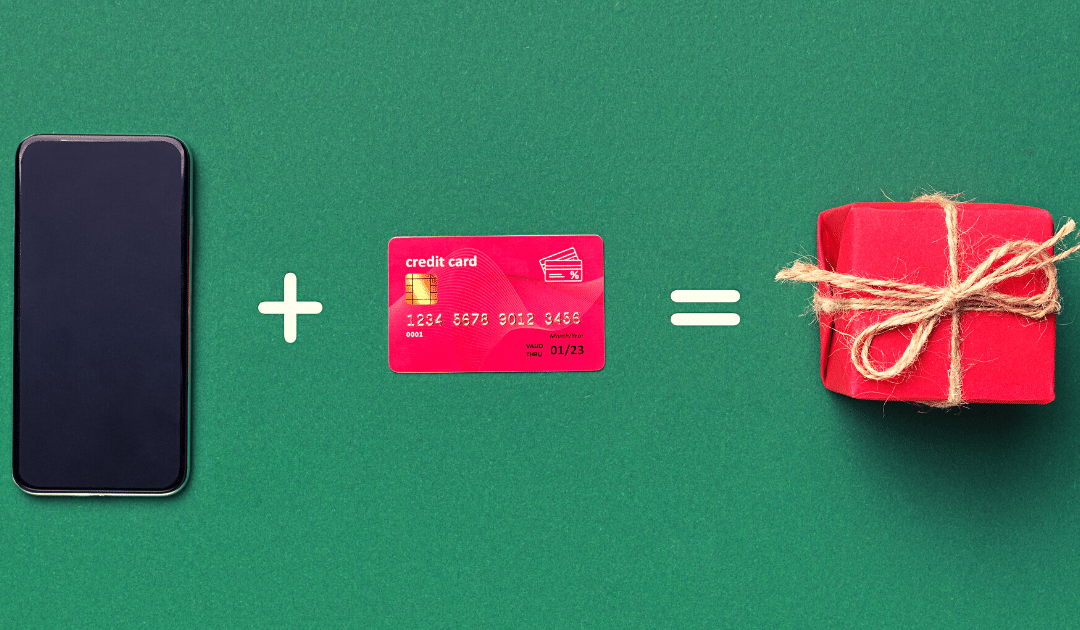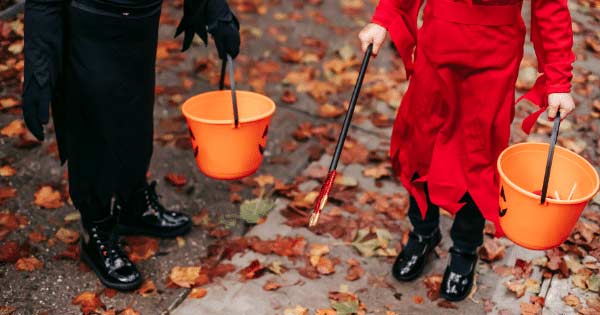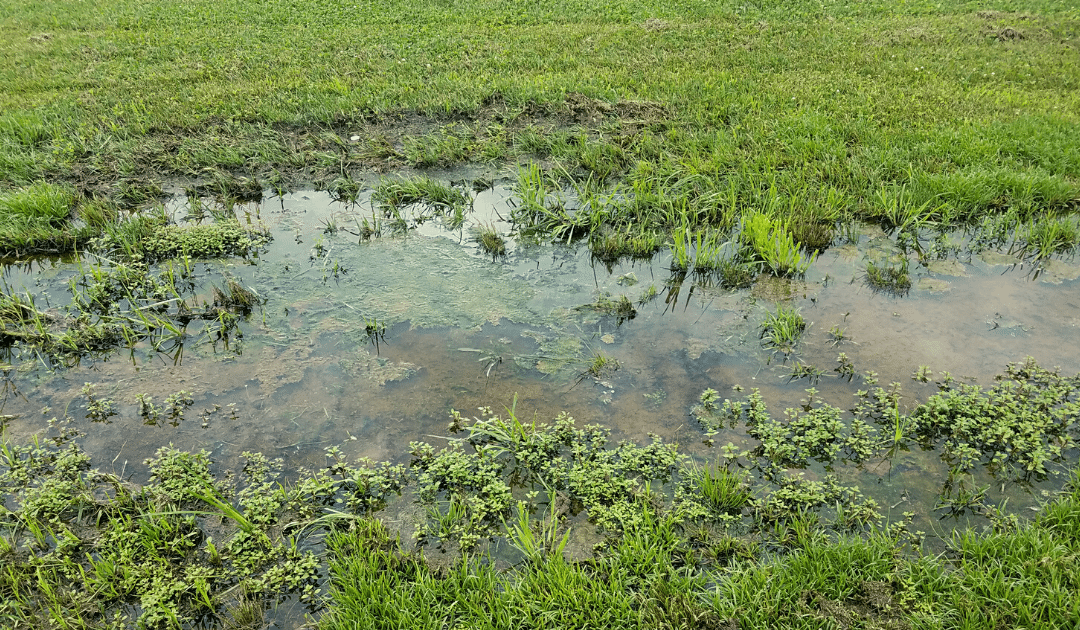
by California Casualty | Auto Insurance Info, Calcas Connection, Good to Know, Helpful Tips |
You’re ready to head home after a night out, but there’s one thing missing: your car. You could have sworn you parked it right here, but it’s no longer there. Vehicle theft can happen anytime, anywhere. When it comes to keeping your car safe, where you park can make all the difference.
Theft by the Numbers
A vehicle is stolen every 32 seconds, according to the National Insurance Crime Bureau. More than a million vehicles are reported stolen each year. California and Colorado have some of the highest number of auto thefts in the country, and of course, urban centers are hotspots for theft. However, thefts happen in the suburbs too, and cars can even be taken from your driveway. In honor of July, National Vehicle Theft Protection Month, we’re taking a look at what you need to know to keep your vehicle safe.
The Worst Places to Park Your Car
Thieves are looking for a chance to steal a car. Don’t give them the opportunity to steal yours. Before you park your car for a short time, or overnight, look around and assess the area for theft potential. Is the area well lit? Are other vehicles parked nearby? Are people around? Is there a security camera or guard? Are there signs of break-ins or damage? All of these can offer clues to an area’s safety.
Avoid empty streets.
Quiet streets and alleyways offer thieves a place to work without interruption. With no one around to witness the theft, they can get in and out quickly with your vehicle.
Avoid poorly lit areas.
Thieves prefer locations where they can work without being seen. Well-lit areas increase their chances of being noticed, while poorly lit and dark locations offer cover.
Avoid high-crime areas.
Do your research before parking in a new place. If the crime rate is high, it’s worth paying for a more secure parking option. High-crime areas aren’t just seedy sections of town. They could be residential neighborhoods that are targeted by thieves.
Avoid empty lots.
You may see lots of cars at office parking lots or at schools. However, when these buildings are not in session, the empty lots provide an easy place for thieves to work. Don’t be tempted to park in an empty lot and put your vehicle at risk.
Avoid remote locations.
Places that are less frequently traveled can be attractive for thieves. Chances are these locations are less often patrolled.
Avoid parking near large vehicles.
Parking your smaller car next to a larger vehicle automatically gives thieves cover. The truck or large car blocks the view so they can work without being easily seen.
How to Protect Your Vehicle
A skilled thief can steal a car in about a minute. However, there are things you can do to make your car seem harder to steal because it will take longer, or they are more likely to get caught.
When parking away from home:
- Park in a garage with security cameras. Park in view of the cameras.
- Be aware of tow truck thieves who come in and tow away your vehicle. When you park, turn your wheel as far to one side as possible. If you have front-wheel drive, park forwards in the spot. For rear wheel drive, back into the spot. This will make it harder to tow your car.
- If you’re parking on the street, choose a busy road where there will be people and other cars the whole time your car will be there.
- Lock your vehicle. The first thing that thieves do is try the doors.
- Hide your valuables out of sight. Even loose change, phone chargers, and other items can tempt thieves to break in.
- Don’t crack your window open on a hot day. An experienced thief can use that to get inside.
- Protect your catalytic converter by etching your VIN onto it.
- Don’t run your car with the keys in it – while you’re somewhere else.
- Keep your registration and insurance in your wallet rather than your glove compartment. That will help prevent the risk of identity theft if your car is stolen.
- Use an anti-theft system. New cars come with one, and you can also add one after market.
When parking at home:
- If you can, park inside your home’s garage. Don’t leave the garage door open. Out of sight is out of mind, and thieves won’t try to steal a car they cannot see.
- Add motion sensor lights to your home and driveway area.
- Don’t leave your key fob in the car. Don’t put it near a door or window inside your home either. Thieves can use the signal to break into your vehicle. Consider keeping keys in a container that doesn’t allow digital signals to pass through.
If your car is stolen, be aware of resources for auto theft victims. Your vehicle is one of your greatest investments. Protect it with the right insurance.
This article is furnished by California Casualty, providing auto and home insurance to educators, law enforcement officers, firefighters, and nurses. Get a quote at 1.866.704.8614 or www.calcas.com.

by California Casualty | Good to Know, Homeowners Insurance Info |
It’s cold out there—a good time to crank up the heat or put a few logs on the fire. While you might enjoy the warmth and ambiance, winter is actually one of the worst seasons for indoor air quality. That’s because we’re nestled inside our comfortable homes along with all of the pollutants and moisture. Fun, right?
Our chances of catching a cold are greater during the winter, especially if our home’s air quality is poor. In addition, trapped pollutants increase our risk of asthma and other respiratory problems. The good news is that we can do something about it! According to the Environmental Protection Agency (EPA), there are 3 basic strategies for better indoor air quality: (1) controlling sources of pollutants (2) improving ventilation, and (3) cleaning the air. Here’s what you need to know to improve your indoor air quality this winter.
Source Control
There are many sources of indoor pollution, ranging from fuel-burning appliances to building materials and furnishings, and even household cleaning products. Take a look around your house to identify the sources of poor indoor air quality, so that you can take steps to reduce their impact.
Airborne chemicals
Also known as VOCS – volatile organic compounds – these “hang” in the air for us to breathe. Scented air fresheners, cleaning products, paint, and even carpets and furniture release chemicals in the air. VOCs can cause health problems from respiratory illnesses to headaches, dizziness, irritation in the eyes, ears, nose, and throat, and more. You can choose low VOC paint, or repurposed/upcycled furniture to reduce some chemicals, and use natural cleaning products.
Tip: A bowl of vinegar with lemon juice will draw out bad smells. Baking soda and lemon juice also absorb odors.
Carbon dioxide
During the winter months, we’re gathered together indoors, which means we’re breathing in close proximity to each other. As carbon dioxide levels rise, that can cause headaches, drowsiness, and other problems. If the levels get high enough, it can even impact decision-making. Limit candle lighting and fireplace use which can contribute to carbon dioxide levels. Open a window for a few minutes, even if it’s cold, to let the fresh air in.
Tip: Add plants like red-edged dracaena, weeping figs or bamboo palm to help convert CO2 to oxygen.
Radon gas
When our doors and windows are shut, it’s easy for radon gas to build up. Radon gas comes from the natural decay of soil. It moves into your home through cracks or even through your water supply. While it may be natural, radon is radioactive and dangerous. It’s the number one cause of lung cancer among nonsmokers. A radon test kit can measure your home’s levels. The EPA offers guidance on radon reduction systems.
Tip: Most states can provide a list of qualified radon service providers. Find more information at https://www.epa.gov/radon/epa-map-radon-zones-and-supplemental-information.
Level of humidity
Air that is too dry – or too moist – can cause problems. The dry air in winter causes dry skin, chapped lips, dry nose, dry throat, and cracked fingertips. High humidity causes mold and condensation which also can affect our health. The ideal level for household humidity should be between 30% and 59%. You can buy an inexpensive monitor to track your household humidity. To help reduce it, use your exhaust and ventilation fans, take cooler showers, or consider a dehumidifier. UV lamps professionally installed in your HVAC system can help kill harmful bacteria and mold before they enter the air supply.
Tip: Run your air conditioner. It may be winter, but your air conditioner can help clear humidity from your home.
Fireplaces
The seasonal scent of wood-burning fireplaces may be wonderful, but that smoke is adding fine particles of dust, dirt, and liquids to the air. Choose clean-burning logs to reduce the effects, and never use wood that is wet, painted, or treated. Gas fireplaces that are vented to the outdoors are better for air quality.
Tip: Warm your chimney flue before starting the fire to help it draw smoke upwards and out of your home.
Dust and dirt
Dust and dirt are respiratory irritants and frequent cleaning can help. Dust and clean your home regularly. Take cushions and rugs outside and beat them to loosen and get rid of dirt. Then wipe them clean with a damp rag to pick up any additional particles and mites. Vacuum rugs and carpets using a vacuum cleaner with a high-efficiency particulate air (HEPA) filter.
Tip: A bristle top doormat helps to trap dirt before it comes into your home. Wash or vacuum your mats regularly to prevent buildup.
Pets
We love our pets but pet hair and dander can affect indoor air quality, especially for those of us who are sensitive or allergic. Air filters and ventilation can help. (See next sections.) Brush your pet regularly to reduce the amount of shedding. Keep a towel by the door and wipe their feet to prevent them from bringing additional dirt into the house.
Tip: Use a window squeegee on your carpet to pick up pet hair. The rubber will loosen the hair and gather it into clumps.
Improved Ventilation
Your HVAC system is your home’s first line of defense against airborne particles. Make sure your system is well maintained and your ducts are cleaned. You also can upgrade the air filters in your HVAC system to a higher MERV rating, if your system allows it. This will increase their ability to remove particles, germs, viruses, and chemical gases. Check with an HVAC professional.
Ventilation devices help air circulation that keeps indoor air clean. They typically are installed in a home’s attic or roof and bring in fresh air on a regular basis while expelling stale air.
Air Cleaners
There are many types of air cleaners for home use, ranging from table-top models to expensive systems for the whole house. An air purifier with a HEPA filter can remove anywhere between 70-95% of airborne particles. Consider buying an air cleaner for each room. Choose one with smart sensors that can detect pollutants in real-time and adjust their fans accordingly.
In addition, you may consider an indoor air quality monitor. These devices can monitor levels of moisture and pollutants, and share information on which part of the house is contributing to poor air quality.
Your home is your greatest investment. Protect it as well with the right home owner’s insurance.
This article is furnished by California Casualty, providing auto and home insurance to educators, law enforcement officers, firefighters, and nurses. Get a quote at 1.866.704.8614 or www.calcas.com.

by California Casualty | Good to Know, Safety |
As we head into the most wonderful time of the year, cybercriminals are gearing up for their busiest season.
While you are carefully crafting your holiday gift list (and checking it twice!) these criminals are perfecting their cyber scams, online fraud schemes, and identity theft plans.
So before you join the millions of others searching out those perfect stocking stuffers, check out these 10 tips to protect yourself and your family online.
1. Secure your home network – Use strong passwords and WPA2 or WPA3 encryption (see tips here to secure your network). Change your router/modem’s default name and pre-set password.
2. Update your antivirus software – Antivirus software is always being updated (thanks to a continuous stream of new threats) so make sure yours is up to date on all your household’s devices.
3. Use a password manager – Create strong passwords on all your devices and use a password manager to keep track. Consider using two-factor authentication to add an extra layer of protection.
4. Update your devices – Operating system and software updates often include security updates. Make sure your computers, tablets, and phones are all updated. Turn on auto-updates so you don’t have to think about it.
5. Use one or two credit cards and monitor them – Using just one or two cards for your holiday shopping will make it much easier to track purchases and spot any fraud early on. Some lenders will even alert you when your card logs transactions that are out of your normal spending pattern and ask your permission before completing the purchase. Mobile pay options such as Apple Pay or Google Pay also offer good protection because they use secure tokens instead of an actual card number.
6. Only shop reputable websites – Big brands and companies are more likely to have strong security on their sites’ transaction platform. But no matter the website, if a link, landing page or online shopping cart looks suspicious, log off immediately.
7. Watch for phishing – Phishing spikes during the holidays. These emails and texts usually look like they’re coming from a source or company you know. They typically ask for sensitive information such as personal or bank information and ask you to click on a link or attachment. Remember that government agencies and reputable companies will never ask you to send sensitive information this way. Delete these messages without clicking on anything. If you’re on the fence about its legitimacy, you can open a separate browser and log in to your account fresh – or call customer service to double-check.
8. Be smart on social media – If you’re headed out of town during the holidays, don’t post plans or info publicly on your social channels. This could make your home vulnerable to a break-in.
9. Be savvy with donations – Many people generously open their wallets during the holidays to help those in need or causes they support. If you’re planning on donating this year, be extra cautious. Stick to reputable, well-known charities. Contact them directly to donate, rather than clicking on a link or giving your information over the phone.
10. Watch your front porch – More online shopping means more deliveries. Bring packages in as soon as possible so they don’t tempt thieves. Neglected packages may also make it look like you’re out of town, making your home a target for burglars.
Make sure all family members are on board with, understand, and carry out the above tips before logging on to find those hot holiday deals. This includes kids and teens who are at home and on screens all day – and who usually aren’t as savvy about security and scams. For more safety tips, check out our articles here and here.
If you’re a California Casualty member, take comfort in the fact that you’re automatically enrolled in ID theft resolution services — which provides free help if you are ever the victim of identity theft. Learn more about the services here.
This article is furnished by California Casualty, providing auto and home insurance to educators, law enforcement officers, firefighters, and nurses. Get a quote at 1.866.704.8614 or www.calcas.com.

by California Casualty | Good to Know, Safety |
Get ready for a scary good time! Halloween is nearly here and kids everywhere will be out trick-or-treating. Remember a safe Halloween is a Happy Halloween; make sure your children are out and about in a way that they can be easily seen.
The ghosts and goblins (or more likely known as little trick-or-treaters) come out after the sun has gone down. Which is fun when you’re behind the mask, but not so fun if you are behind the wheel. When it’s dark, it’s harder for drivers to see pedestrians in the street. Add to that, excited children who may run out suddenly, and the results could be tragic. In fact, children are twice as likely to be hit by a car on Halloween than on any other day of the year.
That’s why it’s important to decide carefully on the costume your child will wear to ensure he/she is the most visible. And before they leave the house, you’ll also want to go over important pedestrian safety rules. You may even decide that accompanying your child is the best thing to do (recommended for children under 12).
Here are some more Halloween safety tips to consider for every vampire, witch, and werewolf!
Tip #1: Use reflective tape on your child’s costume.
Increase your child’s chances of being seen by adding pieces of reflective tape to his/her costume and/or jacket. Do so creatively and you may have a skeleton with glowing bones or a superhero with a gleaming emblem. Reflective tape works by reflecting light back, so wearers will be easily seen in a car’s headlights even in the pitch dark.
Tip #2: Add a glow stick or a clip-on light.
Decorate your child’s costume or candy bag with clip-on lights. These can be Halloween-themed lights or any small clip-on. Consider giving your child glow stick bracelets or necklaces; these are a festive, fun, and bright addition to any costume.
Tip #3: Select costumes with light colors.
Darker color costumes may be spooky but they are hard to see when it gets dark. When possible, choose lighter-colored outfits. If your child insists on a dark color, use tip #1 to lighten it up.
Tip #4: Choose face paint over masks.
Masks can block your child’s vision and depth perception. They also cover up your trick-or-treater’s face so it may not be easily seen. Face paint is a great alternative. You can even find glow-in-the-dark varieties for more visibility. Choose a face paint that is labeled safe for use with children. Test it on your child’s arm before Halloween. If you want a natural version, you can make homemade face paint.
Tip #5: Travel in groups and carry a flashlight.
Whether you walk around with your kids, or they travel with their friends, insist that they go in groups. Large groups – especially with both adults and children – are easier to see. If one or more group members carry a flashlight, that’s added protection. Having an adult also will help keep trick-or-treaters safe. The excitement of Halloween can overtake a child’s focus on safety.
Tip #6: Don’t walk and text.
You may often text while you’re walking but it’s not a good idea –and while supervising children on Halloween, it’s an especially bad idea. A study from Stonybrook University showed that we are 61 percent more likely to veer off course when we are walking and texting. Not only could you walk into traffic – or other people – or step off the curb, but your attention is distracted from the trick-or-treaters in your care.
Tip #7: Choose safe, lighted routes.
If you are able, choose a residential neighborhood with street lights and sidewalks for trick-or-treating. Walk on the sidewalk and cross at the corner, looking first for cars. If there are no sidewalks, and you need to walk in the street, you should keep to the left and walk facing cars. This will ensure you see cars coming toward you. Halloween is not the time to jaywalk; it can be especially dangerous. Do not walk out between cars, and definitely do not run into the street for any reason.
Tip #8. Watch for cars.
Watch for cars that are turning corners or pulling out of driveways. They could surprise you if you’re not expecting them—and you could surprise them by being in their path. If you’re the one driving at night on Halloween, look out for pedestrians.
For more safety tips, see our blogs on Halloween fire safety and Halloween safety tips for pets.
Have a Happy Halloween!
This article is furnished by California Casualty, providing auto and home insurance to educators, law enforcement officers, firefighters, and nurses. Get a quote at 1.866.704.8614 or www.calcas.com.

by California Casualty | Good to Know, Homeowners Insurance Info |
An attractive nuisance is anything on your property that is attractive to children, but in turn, could also put them in danger.
Examples of common backyard attractive nuisances include:
-
- Pools
- Hot tubs
- Trampolines
- Swingsets
- Firepits
- Fountains
- Treehouses
- Playgrounds
While these nuisances all serve as great ways for children to get outdoors and enjoy the summer sun, without the proper precautions, they can become problematic. In fact, attractive nuisances cause so many injuries when kids are out of school that summer is also known as “trauma season” among public health officials in the U.S. This is because unintentional deaths and serious injuries increase dramatically among children in the summertime.
Not only will these objects of entertainment put your own child at risk for serious or fatal injury, if one of their friends comes over to play one day and gets hurt on an attractive nuisance in your yard, you will be held liable for their injuries.
How to Minimize Your Risk
An attractive nuisance isn’t just limited to objects of entertainment like pools; they can also be anything that is on your property that draws curiosity like construction, weapons, grills, landscaping, lawn equipment, ponds, old cars, or appliances, etc.
This doesn’t mean that you will have to go and give all of your nuisances away, instead take the proper precautions to prevent the nuisances from causing harm.
Minimize the risk of an accident or injury by understanding what you have on your property that could be considered an attractive nuisance and take the necessary steps to safeguard against any future accidents.
-
- Keep your property clean. Pick up dangerous debris and clean up after projects that you have completed. If you have old items that you are using anymore, sell or get rid of them.
- Make dangerous items inaccessible. Keep dangerous weapons locked away in a safe, equipment, and vehicles in a garage or shed, and put a cover on pools, fire pits, grills, and hot tubs.
- Install a gate and lock system. If there is no way to make items in your yard inaccessible try installing a fence or locked gate with a no trespassing sign to help keep curious children out.
- Always supervise. If you have an attractive nuisance in your yard, never let your children or their friends play outside without adult supervision.
- Have adequate coverage. Make sure you have enough liability coverage with your homeowner’s insurance. Talk to your insurance agent and review your policy.
If you fail to minimize the risk of injury and a child in your neighborhood harms themselves (or worse) on your property, you may be subject to legal action. Read your local laws and use good judgment, if you feel like you have an item of concern in your backyard, use the steps above to help prevent an accident.
How an Attractive Nuisance Affects Your Insurance
Insurance agents look at your property to determine your home insurance rate. Certain features of your home or property could impact your rate because of their degree of danger. For instance, if you have an in-ground pool in your backyard you will likely have a higher rate because a pool increases the risk of danger.
When you speak to your home insurance agent you will need to disclose if you have any attractive nuisances on your property to protect you from getting future claims rejected, if an accident were to happen on your property.
Many people assume that their homeowner’s insurance will provide them the protection they need if someone gets injured at their home, but this isn’t always true. If you have an attractive nuisance, protect yourself and your family, talk to your insurance agent and ask about increasing your liability protection or about adding a personal umbrella policy to your homeowner’s insurance.
This article is furnished by California Casualty, providing auto and home insurance to educators, law enforcement officers, firefighters, and nurses. Get a quote at 1.866.704.8614 or www.calcas.com.

by California Casualty | Calcas Connection, Good to Know, Homeowners Insurance Info |
Spring is here! And so are spring storms, but spring showers don’t just bring flowers, they can also bring more water than what your yard can hold. And this standing water around your house can cause water damage to your home- costing you more than you think.
By definition, standing water is a body of water that does not move or sink into the ground. It can be caused by a number of factors: heavy rain, over-watering, poorly draining soil, improper grading, incorrect landscaping, low areas in your yard, and even water line leaks or bursts.
If you have standing water in your yard for multiple days, it can cause serious damage to your home. Not only will it be an eyesore that can ruin your grass and draw unwanted bugs, but stagnant water on the side of your home can also seep into small cracks or pores in your home’s foundation and get into your crawl space or basement, which can lead to water damage & more.
Here’s why you should address the standing water near your home now, and how you can prevent it from happening in the future.
Standing Water Can…
Ruin your basement. Water can cause cracks in your home’s foundation. This is how water enters your basement or your crawl space. Once inside it can create a musty odor and add dampness that will completely ruin flooring, drywall, furniture, electronics, etc.
Produce mold & mildew. High levels of condensation and humidity inside of your basement or crawl space create an environment for mold and mildew to thrive. This could not only affect your home, but it could also cause major health issues for you and your family.
Breakdown your home’s foundation. Over time, standing water that has made its way into your cement foundation will start to cause shifting and bowing of your structure. This is the beginning of the breakdown of your home’s foundation. If not taken care of- doors will no longer close, floorboards will start to squeak, steel beams may have to be inserted, and it could even lead to structural collapse.
Cost you thousands of dollars in repairs. A homeowner spends over $3,000 on average to repair damages to their home and property caused by water. Preventive maintenance and early detection are key to helping you save your home and your wallet.
But that’s not all, standing water can also draw unwanted pests: mosquitoes, roaches, termites, ants, silverfish, and other pests thrive in moist environments. They will seek damp areas and make your home their home if you don’t address the issue quickly.
Here’s how you can prevent standing water from getting into your home this spring.
How to Prevent Standing Water
1. Check for Proper Roof Drainage
Make sure every drop of rain will drain off of your roof correctly- starting at your gutters. Make sure they are free of leaves and sticks and that you have an attached downspout that is also clear of debris. It is also important to make sure your downspout has a downspout extension that will move water away from the foundation of your home.
2. Monitor Your Sprinkler Usage
If you see standing water, make sure to check that your sprinklers are not overwatering your lawn. First, check to make sure the sprinkler heads are functioning properly and not broken. If there is no issue, you will likely just need to reset your sprinklers to run at a less-frequent timespan. After resetting, if you are still seeing patches of barren or muddy lawn, you may have a leaky valve. Valves are responsible for distributing the water throughout the entire system, and if damaged they will need to be replaced right away.
3. Make Sure Your Yard is Correctly Graded
Grading, also referred to as lawn leveling, is the process of leveling your lawn to allow for the proper drainage of water. If you have water that is pooling around your foundation or your house is sitting on a low level, you may need to look into re-leveling your yard. Grading involves the moving of topsoil onto the yard. You will then even out the low spots with the soil and form a downward slope (around 2%) from your home’s foundation. Leveling is an intricate process, and if your yard needs re-leveled, you may need to hire a professional.
4. Aerate Your Lawn
Aerating your yard means to perforate the soil with holes (4 – 6 inches deep) to allow water, air, and other nutrients to better absorb into the soil. Not only will aeration lead to a greener, healthier lawn, but it will also alleviate soil compaction and allow water to better absorb during rainstorms. The best time to aerate your lawn is during spring and fall.
5. Mind Your Landscaping
Improper landscaping can cause water to sit at the base of your home’s foundation and ultimately make it into your home. When landscaping, avoid making any changes that will block drains or downspouts. Make sure that all of your landscaping slopes downward to create runoff and that all downspout extensions or drainage systems extend beyond your planting beds leading the water away and far from your foundation.
6. Install a Drainage System
If you are constantly struggling with standing water in an area of your yard, it may be best to look into installing a yard drain. Yard drains act like shower drains. They prevent flooding and move the water away from your yard through hidden pipes to a dry well. The dry well will then collect the water underground and slowly percolate to the soil around it
Standing water is a serious, yet largely overlooked, issue that can have serious consequences. If water has been in your yard for multiple days and won’t drain, don’t neglect it. Look for the cause of your problem or reach out to a professional. Acting today will save you time, money, and headache tomorrow.
This article is furnished by California Casualty, providing auto and home insurance to educators, law enforcement officers, firefighters, and nurses. Get a quote at 1.866.704.8614 or www.calcas.com.






